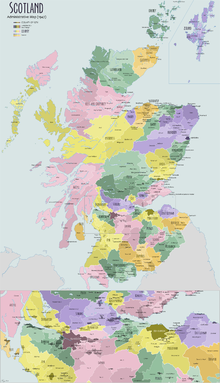District (United Kingdom)
A District is in the United Kingdom, a county of the middle management level with different histories and function in the different parts of the country. In terms of size and tasks, a British district is comparable to a German rural district or an independent city .
England
As early as 1965, 32 London boroughs were set up, later a special form of the English districts. In 1974 296 so-called Non-Metropolitan Districts were introduced nationwide in England as subdivisions of the Non-Metropolitan Counties . They replaced the subdivisions of the counties , which were previously known as urban districts or rural districts . Most of the non-metropolitan districts in England have between 25,000 and 200,000 residents. At the same time, 36 metropolitan boroughs were formed in six metropolitan counties in 1974 .
Depending on its structure, historical significance or size, an English district can have the status of a city or a borough .
In 1996, a number of non-metropolitan districts were raised to Unitary Authorities and removed from their counties. The administrative functions of county and district are combined in the Unitary Authorities. In 2009 another form of administration followed, in which further parts of the country were divided into unitary authorities. This reduced the number of currently existing non-metropolitan districts to 201. In addition, there are now 56 Unitary Authorities in England.
Wales
In 1974, 47 districts were formed in Wales as subdivisions of eight counties. In 1996, the counties and districts in Wales were abolished and replaced across the board by 22 principal areas.
Scotland
With the Local Government (Scotland) Act 1889 most of the newly established administrative counties (counties) were divided into districts. They were subordinate to District Committees, which were composed of the members of the district elected to the County Council and a representative of each of the parishes located in them . Her responsibility extended to the maintenance of roads and public health. Since the parishes were abolished as self-governing units with the Local Government (Scotland) Act 1929, which came into force the following year , the districts received directly elected District Councils. At the same time, they appeared as administrative units alongside the Burghs , who were gifted with a town charter , which in turn were divided into Small Burghs and Large Burghs .
In 1974, 53 districts were formed in Scotland as subdivisions of nine regions . In 1996, the regions and districts in Scotland were abolished and replaced across the board by 32 unitary authorities.
Northern Ireland
In 1973 the traditional counties were abolished in Northern Ireland and 26 districts were established, which were merged into eleven districts on April 1, 2015.
Web links
- United Kingdom: Local Authority Districts, Counties and Unitary Authorities. (PDF; 3.3 MB) Office for National Statistics, 2013, accessed on July 7, 2013 (overview map).
Individual evidence
- ↑ Office for National Statistics: List of administrative areas in the UK ( MS Excel ; 209 kB)
- ^ Mabel Atkinson: The Organization of Local Government in Scotland . Political Science Quarterly, 18 (1), pp. 75f. (English)
- ↑ Local Government (Scotland) Act 1929 on the UK Government Act, accessed August 14, 2018
